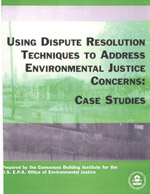|
Using Dispute Resolution Techniques to Address Environmental Justice Concerns:
Case Studies

Prepared by Consensus Building Institute
for the US EPA Office of Environmental Justice, 2003.
Related Links:
A leak at a petrochemical plant releases a plume of sulfuric acid across 15 square miles,
sending 24,000 people to the hospital. A refinery releases more than 100 tons of a toxic
substance over four communities for 16 days, causing neurological disorders, skin
reactions, and eye problems. A neighborhood built over abandoned crude oil storage pits and
exposed to hydrocarbons for 20 years experiences a wave of cancer and lupus cases. A
railroad tanker car parked several yards from homes and a community center releases
3,300 gallons of hydrochloric acid into the air, causing the evacuation of 300 people.
For better or worse, these kinds of accidents and discoveries of contamination open a
window of opportunity in which environmentally overburdened communities can engage
with the industrial facilities in their midst. The crises offer rare glimpses into the routines
and standard operating procedures that allow facilities to function in close proximity to
residential neighborhoods, conform to permit and other regulatory requirements, promote a
perception that the risks they present are within acceptable limits, and avoid state- or
citizen-sponsored threats to the legitimacy of their operations. Advocates of environmental
justice are learning how to take advantage of these moments, for they represent clear yet
fleeting chances to improve environmental conditions, alter community-corporate relations,
and consider more holistically the interests of those who reside in what are typically low-
income communities of color.
But do such opportunities actually result in change for the better? Do these crises
encourage improvements to plant safety, preparedness, emergency response capabilities, or
citizen roles in mitigation, monitoring, and decision making? Traditionally, residents in
overburdened communities have responded to these kinds of crises with litigation, with mixed
results.
This report looks at other means of redress: it contains six case studies that point to the
growing use of "alternative dispute resolution" approaches within environmental justice
communities, and illustrates the varying results achieved through these means. Our goal
is to make sense of early efforts by residents to negotiate with the owners and operators
of these facilities, to consolidate lessons learned and to present advice regarding
community-corporate negotiation for future generations of activists, community-based
organizations, regulators, elected officials, and researchers.
The case studies were commissioned by the U.S. Environmental Protection Agency's Office
of Environmental Justice. The Office is interested in developing a better understanding of
the many potentials and pitfalls of using a variety of dispute resolution mechanisms to
resolve environmental disputes in communities faced with either a growing threat of
pollution or the aftermath of an industrial accident.
The cases represent the results of six months of field research, including site visits, interviews with almost 80 residents and key informants, archival research (primary sources and
print media), and the analysis of environmental data from government agencies. Three
regions representing clusters of dangerous industries were chosen for the six cases:
Contra Costa County, California; Houston, Texas; and North Denver, Colorado. Within each
region, two cases were chosen for which substantial documentation of environmental burdens, dispute histories, and the negotiations that took place was available. Each case
presents information regarding the geography and social forces at
work within the community, antecedents to conflict with area
industries, the development of a specific dispute, and steps taken
to resolve the dispute. A final chapter offers a discussion of lessons learned by the communities in the many months they have
spent organizing, pursuing litigation, experimenting with conflict
resolution, and implementing the agreements that resulted.
|


